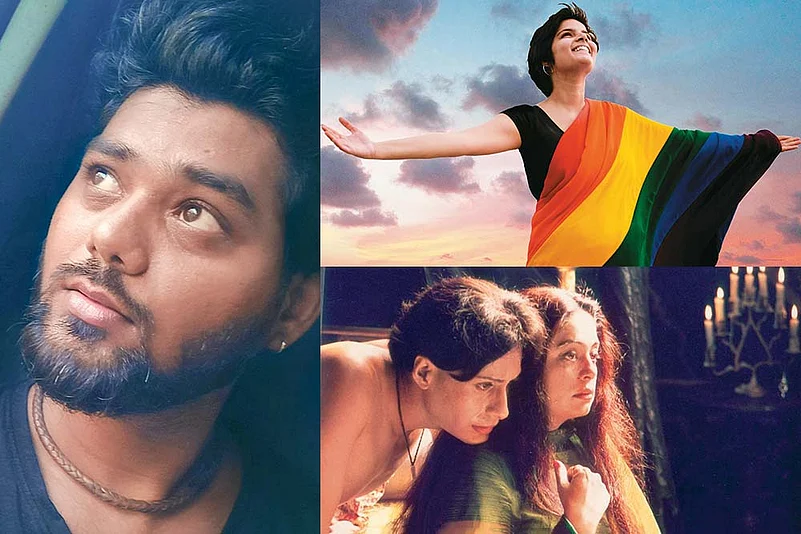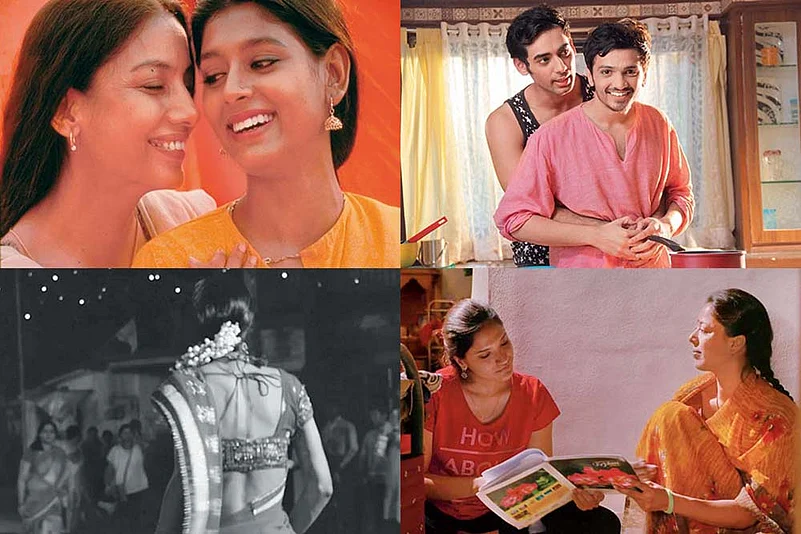Fire, made by Deepa Mehta, was released in 1996, and there were protests. They revealed a society that was completely at unrest with the LGBTQ community. Until then, Bollywood and language cinemas portrayed its members in specific stereotypes. They could be comical, prostitutes, and beggars. But they couldn’t be normal, and an inherent part of the society. Less than three decades later, things have changed, albeit not in the manner they should have. Today, you are more likely to watch a Ladli (Hindi) or U Ushacha (Marathi).
Ladli doesn’t just have the third-gender characters. It is a poignant and true story about a transgender by the same name. It is a tale of a person for whom life became a journey to find some meaning in this cruel world. She renders tender hopes about being accepted, being part of the society. Instead, what she gets is harsh treatment and unkind words. She yearns for love, real love, but realizes that it is often coupled with judgmental behavior and conditions. Ironically, when she finds love, it is difficult for her to accept it.
Film-maker Sudipta Kundu became obsessed with Ladli, when he saw her brawl with the police on a weekend night. Unlike what he had heard and seen, the encounter was attention-grabbing. “She was spontaneous and logical. I tried to discontinue the fight,” he reminisces. Later, he asked the local paan-shop owner about the cause of the fight. He was told that it was a regular fight for her survival. He was advised not to be involved. But the brawl and comments left Kundu in deep thought over the next few days.
Initially, the film director planned to do a photo-shoot to depict Ladli’s life through photographs. But as he explored her life, he understood the cruelties and sensitivities involved, he figured out a documentary film was the best option to show it like it is. Given the existing stereotypes in Indian films, Kundu felt that this was a medium that had to be explored. “In the 1990s, a few efforts were made, like Tamanna, but films on the community were few,” he explains in an exclusive interview.
Today, people like Rohan Parashuram Kanawade, who made the short film, U Ushacha, don’t just portray a community member as the main protagonist. What they add is a sketch of how they are as normal as heterosexuals, possess the same emotions, feelings, and yearnings, and how the society still views them. The Marathi film, for instance, is about an illiterate single mother in rural Maharashtra, who feels drawn to the female teacher of a local primary school. Like others in love, the attraction is innocent and pure, and empowers her. She was like any other next-door neighbor.
Kanawade was careful to stay away from popular, and wrong, perceptions that exist among the heterosexuals. These portrayals make the audience think that “gay man means a feminine man, and lesbian implies a butch woman”. At a personal level, when he came out, some of his friends couldn’t believe it. They said that he didn’t look like a gay. This is why he steered away from stereotypes, and attempted to normalize the community in this, and the other films he made.
“Since I made Usha, a large number of heterosexual viewers told me that they didn’t want the film to end. In fact, they wanted to see the love between the two lead women to bloom,” explains Kanawade. Many advised him that he should convert it into a full-fledged feature film. This was an achievement of sorts, a successful attempt to change existing mindset. More importantly, it made the audience feel that the community members were just like any other human beings. They harbored the same hopes, ambitions, and aspirations.
Sundar (Beautiful) is another short film made by Kanawade. The story deals with a boy, Jayu, and is set in a chawl in Mumbai. On the last day of the Navaratri festival, the young hero listens to the dandiya music that makes him restless. His heart sinks as he sees the girls dolled up for the night. Everyone is heading to the ground to dance. Jayu too longs to go, but his mother doesn’t want him to step out of the house. She was embarrassed; the year before, her son had dressed in a sari for a fancy-dress competition.

Kanawada (Left) made LGBTQ-themed films; stills from Purple Skies (right) and Darmiyaan.
Jayu, however, went for the dance. Onlookers laughed, mocked, and whistled at him. For them, this was another reason to ridicule the little boy, to make fun of him. But Jayu did not care. He wanted to live life the way he wished, and seek personal happiness. That is, until he spots his mother among the hecklers. Still, Sundar is a tale of millions of people in this country, who despite being shunned by the majority, realize their inner beauty, accept their internal truths, and move on happily with their lives.
The above-mentioned movies, and several others, were showcased at KASHISH, the annual International Queer Film Festival, which is the largest in South Asia and is held in Mumbai. It deals with the LGBTQIA+ community that comprises lesbian, gay, bisexual, pansexual, transgender, gender queer, queer, inter-sexed, a-gender, asexual, and allied sections. Every year, the festival screens around 160-180 films from 35 to 40 countries. Out of these films, 30 to 35 were from India in the past three years.
Sridhar Rangayan, writer and director of award-winning LGBTQ-themed films, and festival director of KASHISH, elaborates, “In 2019, we screened two diverse and distinct films about transgenders. One from Kolkata, Nagarkirtan, was directed by Kaushik Ganguly. It was about a beautiful romance between a flute player and young transgender person. It dealt with the sensitive topic of the in-fighting within the hijra community.” The second was a Malayalam one, Njan Marykutty. It was about a transgender who faces discrimination from family and society, but becomes a police officer.”
Regional films are the real gamechangers. Naanu Avanalla Avalu in Kannada won two National Awards. Khejdi is a film set in Rajasthan, and starred the popular actor, Ashish Sharma. Of course, there are the unforgettable movies by the late Rituparno Ghosh – Arekti Premer Golpo and Chitrangada, both in Bengali. Both of them deal with the lives of the transgenders with sensitivity. Whether it was deliberate or not, they were instrumental in evolking insightful realizations among their audiences.
Apart from these, a number of short films and documentaries explored the community’s need for family acceptance, housing, jobs and love. A Monsoon Date, which is directed by Tanuja Chandra, and stars Konkana Sen Sharma, exposes the stigma faced by transgender persons when they are looking for a loving partner. Another filmmaker who has consistently made LGBTQ-themed films is Onir. His My Brother Nikhil and I Am not only won awards, but stole the hearts of the viewers. Shab, another of Onir’s movies, includes one of the most beautiful gay characters seen in Indian cinema.
But the spectrum needs to expand. Sridhar explains, “Also, the conversations have moved beyond the more visible trans-women to include stories about trans-men, intersex persons, gender queer/non-binary persons who fall under the umbrella of transgender currently. But their issues and lives are different and distinct, and we need more stories to be told. That’s why the 11th edition of KASHISH to be held May 20-24, 2020 has the theme, ‘Moving Forward, Together’, focused on the marginalized within the LGBTQIA+.”
After Section 377 was decriminalized in September 2018, film-makers seem to feel a sense of freedom to explore narratives with more nuanced stories. In early 2019, two films were released. Evening Shadows by Sridhar Rangayan was about a mother-son bond that is put to test when he tells her that he is gay, and the hardships she faces to accept him. Ek Ladki Ko Dekha Toh Aisa Laga by Shelly Chopra Dhar starred Sonam Kapoor in a lesbian relationship. A soon-to-be-released Ayushman Khurana starrer, Shubh Mangal Zyaada Sawadhan, promises to be a mainstream gay film.
The other development is the digital web series space, where one can tell stories that are on the cutting edge. Series like Romil and Jugal, Four More Shots, and Made in Heaven have LGBTQ characters in the lead roles, and proved to be game-changers. Still, on-the-ground changes are needed for the movement to take off. The first is the lack of finances to support LGBTQ films. There are no government grants, nor are there private funds. The film-makers rely on their own funds, or their friends’, or seek crowd-funding.
Says Sridhar, “What we need are funds dedicated to LGBTQ stories.” He confidently adds, “The mood is upbeat, and the rainbow is flying high. What it needs is the backing of commerce and platforms like KASHISH to break through the barrier.” And, of course, there is a need for a sensitive and sensitized audience that can appreciate the new narratives in the new movies. Mass and popular entertainment is a sure-fire way to change people’s thinking and mindset. It can be more powerful than laws.
















